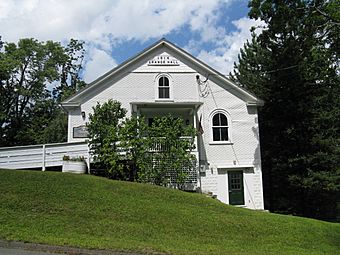Chesterfield Center Historic District facts for kids
Quick facts for kids |
|
|
Chesterfield Center Historic District
|
|

The former grange hall, now a senior center
|
|
| Location | Main Rd., South St., North Rd., Bagg Rd., Bryant St., Chesterfield, Massachusetts |
|---|---|
| Area | 273.6 acres (110.7 ha) |
| NRHP reference No. | 08001177 |
| Added to NRHP | December 11, 2008 |
The Chesterfield Center Historic District is a special area in Chesterfield, Massachusetts. It's like a time capsule that shows what the town looked like in the 1700s and 1800s. This district was added to the National Register of Historic Places in 2000 because of its important history. It helps us understand how people lived in a farming community on a hill long ago.
Contents
Exploring Chesterfield's Historic Center
How Chesterfield Began
Chesterfield is a town in the beautiful Berkshires area of Massachusetts. People first settled here in 1760. The town officially became a town (incorporated) just two years later. The main village grew around a central crossroads. This was where Main Road (also known as Massachusetts Route 143) met North Road and South Road. These roads led to other nearby towns.
Unlike some older towns, settlers in Chesterfield often built their homes on their large farms. They did not always live close together in a village center. The oldest houses in the village date back to the 1770s. One house even has parts from around 1768. The village stayed an important center for town activities throughout the 1800s. Even so, most of the town's businesses were in other areas, like West Chesterfield.
What Makes the District Special?
The historic district itself is shaped a bit like the letter "T". It mainly stretches along Main Road, both east and west of the main crossroads. It also goes south along South Road. Some properties on Bagg and Bryant Roads are included too. These roads form a rough square with Main and South Roads.
Buildings in the District
The district has many different kinds of buildings. You can find several important town buildings here. These include the town hall, the library, the grange hall, and the Congregational Church. There is also one commercial building, which used to be a general store. Many houses are also part of the district.
These buildings show different styles of architecture. They range from the traditional Georgian style to the later Victorian Queen Anne style. Most of the houses are simple versions of these styles. They are usually one-and-a-half to two-and-a-half stories tall. They are also built with wood frames.



